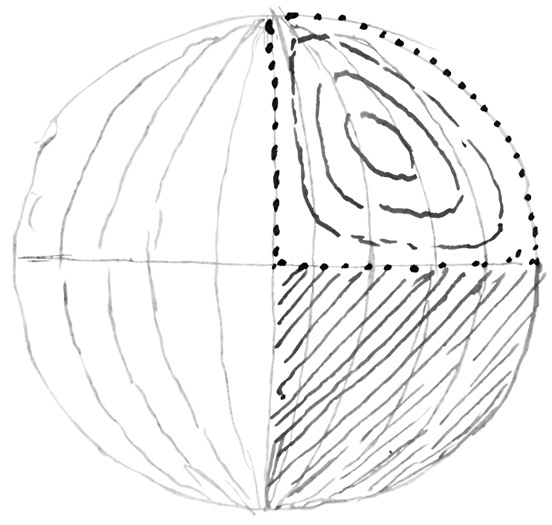From G. H. Darwin 1 May 1876
Trin. Coll. Camb
May 1. 76.
My dear Father,
I’ve been sticking to my mathcs. very hard, tho’ I read the newspaper & play tennis & see people as much as I can—but it’s very difficult because I’ve been so intensely interested that I cd’nt rest until I got out a preliminary numerical result.1 But I hope I shall be able to think of somethg. else now, tho’ there’s lots more to do.
In the first place I think Evans’ estimate of the effect utterly wild.2 My supposition is as follows.

Let this figure represent one hemisphere of the world just as in ordinary atlases. Then I suppose the part surrounded by dotted lines to become gradually elevated, whilst the shaded part sinks in exactly the same manner. The dotted line is a shelving sea coast, whilst the centre rises to an elevated table-land, so that the oval lines drawn on the figure about represent lines of equal level.—ie they are contour lines I propose to assume that the elevation takes place at the rate of 1 foot per century and that the elevation continues until the highest point or table land in the central oval is 10,000 ft above the Sea. I want particularly to know what you think of my rate of elevation, as that is I conceive an important element—& to a less to degree whether I put my mountains too high.
Such an elevation as this shifts the pole of figure of the earth about 15 yards for every foot of elevation, so that the whole 10,000 ft wd move the pole 1°30′ of latitude It shifts away from the elevated region—e.g if the elevation were from long: 0° to long 90°E, the pole wd tend towards the equator in long. 135°W by 1°30′.
(Evans suggests 20° to 15°!3 He forgets what eggshells continents are.)
This is the other hemisphere & p is the new pole in latitude 88°30′

I have not yet determined whether it will tend to make the arctic circle descend & the tropics rise, & this will be by far the most difficult part of my problem
I could take other distributions of mountain & deep ocean, but for the present I shall confine myself to this
I had a very prosperous letter from Hen: yesterday, of wh. I was very glad to hear.—4 Sidgwick comes back today & I shall tell him what you think of his article.5 F. Balf.6 says he does’nt agree with it. I’ve read it once & think it very clever, but it’s stiff readg & out of my depth.
I’m wearing a one eye’d pair of specs. for readg. & think it suits my bad eye & makes the letters blacker & clearer
I hope London is suiting you & that poor Mother has’nt been knocked down with it7 I shall come home for a day or two to meet Leo.8
I’ve got a cold hanging about me, wh. is upsetting me a little now, tho’ Im going on well on the whole.
Your affec. Son | G. H. Darwin
Footnotes
Bibliography
Evans, John. 1876. The anniversary address of the president. [Read 18 February 1876.] Quarterly Journal of the Geological Society of London 32, Proceedings, pp. 53–121.
Sidgwick, Henry. 1876. The theory of evolution and its application to practice. Mind 1: 52–67.
Summary
Writes of his "geo-mathematical" work.
Letter details
- Letter no.
- DCP-LETT-10489
- From
- George Howard Darwin
- To
- Charles Robert Darwin
- Sent from
- Trinity College, Cambridge
- Source of text
- DAR 210.2: 52
- Physical description
- ALS 6pp
Please cite as
Darwin Correspondence Project, “Letter no. 10489,” accessed on 23 April 2024, https://www.darwinproject.ac.uk/letter/?docId=letters/DCP-LETT-10489.xml
Also published in The Correspondence of Charles Darwin, vol. 24


